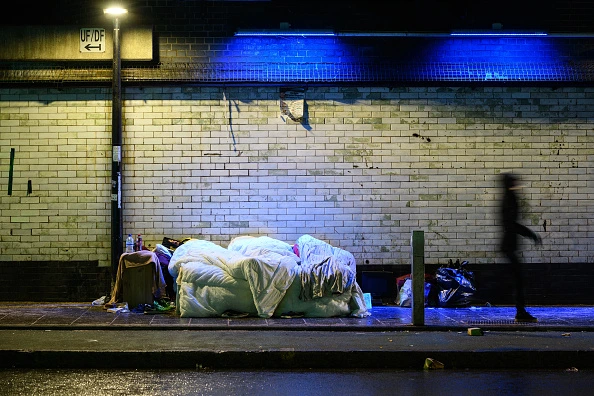
A record number of young people were homeless or at risk of homelessness in the UK last year, with huge youth homelessness surges in many parts of the country driven by the cost-of-living crisis.

The latest annual data from youth homelessness charity Centrepoint collates Freedom of Information requests from every council in England, combined with public data front the devolved nations, to create a picture of the youth homelessness crisis in the country.
Across the UK, 129,000 16–24-year-olds approached their council between April 2021 and March 2022, saying they were homeless or at risk of becoming homeless – a 6% increase from the previous year.
Across England, almost one in 50 young people presented at risk of youth homelessness in 2022, with the highest rates in the East Midlands, north-west and London.
“Young people often bear the brunt of any economic downturn and this cost-of-living crisis, following hot on the heels of the pandemic, is no different,” says Alicia Walker, head of policy, research and campaigns at Centrepoint, said.
“Last year, we surveyed young people to find out how they were coping with rising costs and, in most cases, they simply weren’t. Many were skipping meals and worried about paying bills and rent – so it’s hardly a surprise that we're seeing huge and increasing numbers of them facing homelessness. ”
In Nottingham, over 2,500 young people presented at risk of homelessness, 240% higher than Centrepoint’s estimated for last year, and 80% higher than 2018/19 when Nottingham council last provided the data.
In Tower Hamlets, Centrepoint estimates around 1,900 young people were homeless or at risk, more than four times the number the previous year.
Spiralling rent likely linked to youth homelessness
Walker says it’s not always possible to pinpoint the exact reasons for extreme rises in certain areas from the data, but that the rises in many urban areas are likely linked to spiralling rent prices. She says the number of people ringing the Centrepoint helpline because they face eviction has doubled in recent months.
“The scale and increase of youth homelessness in the last year shows we are letting young people down,” Walker said. “The situation in England is particularly dire and it’s hard to see how charities, councils and others can weather the storm of increased demand and diminishing spending power much longer.”
Despite the introduction of the Homelessness Reduction Act in 2018, there hasn’t been an increase in assessment rates. Just 68% of young people who approached their local council were assessed in the year to April 2022, meaning a third – around 40,000 young people – were not even checked for eligibility let alone offered support.
Across the UK, just 61% of young people who approached their local council were offered support, a 1% decrease from the previous year.
Centrepoint says its helpline regularly hears from young people who say their council demanded “proof” of homelessness, or even told the young people to sleep rough for the night.
“This puts young people’s lives at risk but it's hardly surprising in a world where local authorities barely have the budgets to deliver their statutory duties at the moment,” says Walker.
Among the 75 local authorities that recorded 500 or more young people contacting the council at risk of homelessness in the year to April 2022, only 17 had support rates above the national level of 61%.
The highest rates were in Sheffield (812 youth homelessness presentations) and Lambeth (660 presentations), which both offered support to 96% of young people. Manchester, the local authority with the highest number of annual presentations in 2021/22, offered support to 74% of the 2,621 young people who reached out.
Meanwhile, in a number of the country’s local authorities, less than a quarter of young people were offered support.
In Nottingham, only 26% were offered support, leaving over 1,800 young people at risk of homelessness. Nottingham has not provided data for the past two years, but in 2018/19 when youth homelessness levels were half as high, 65% were offered support.
“There are no simple solutions here but the question has to come down to the sort of country we want to be,” says Walker. “If we want to see an end to youth homelessness then that has to start with the government putting forward a credible plan.
“That of course means more money for rough sleeping and prevention services and age-appropriate accommodation – but it also means getting around the table with local government and charities and thrashing out a strategy that stops the number of young people reaching crisis point increasing year-on-year indefinitely.”






